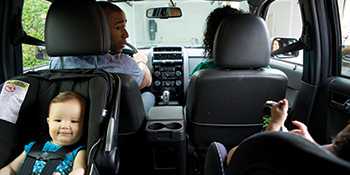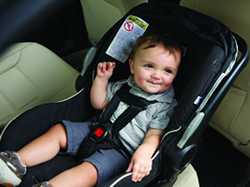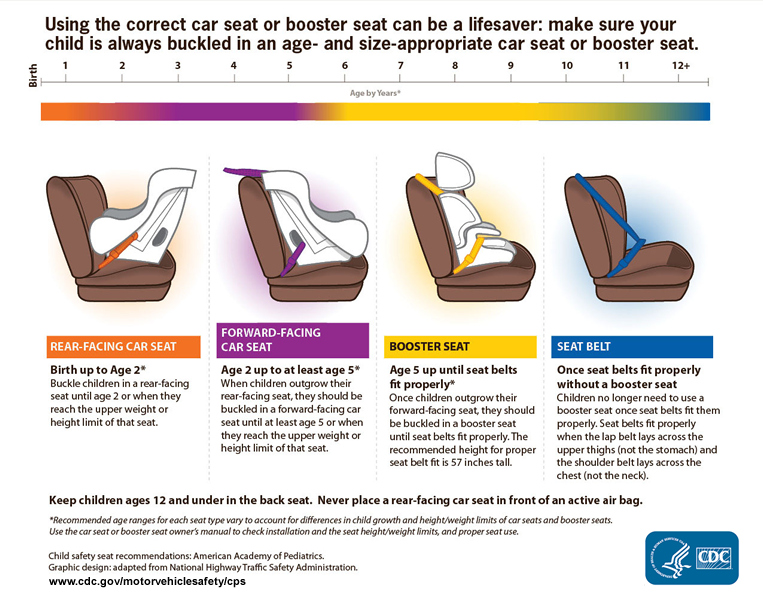Child Passenger Safety: Get the Facts
Scope of the Problem

Motor vehicle injuries are a leading cause of death among children in the United States.1 But many of these deaths can be prevented.
- In the United States, 663 children ages 12 years and younger died as occupants in motor vehicle crashes during 2015,4 and more than 121,350 were injured in 2014.1
- One CDC study found that, in one year, more than 618,000 children ages 0-12 rode in vehicles without the use of a child safety seat or booster seat or a seat belt at least some of the time.5
- Of the children ages 12 years and younger who died in a crash in 2015 (for which restraint use was known), 35% were not buckled up.4
Risk Factors for Children & Teens
- Of the children who died in a crash:
- More black (45%) and Hispanic (46%) children were not buckled up compared with white (26%) children (2009-2010; aged 12 and under).6
- More of the older children (43% of 8-12 year olds) were not buckled up compared with younger children (36% of 4-7 year olds; 26% of <4 year olds) in 2015 (with known restraint use).4
- From 2001 to 2010, approximately 1 in 5 child (<15 years old) passenger deaths in the U.S. involved drunk driving; 65% of the time, it was the child’s own driver that had been drinking (BAC ≥ 0.08 g/dl).7
- Most child passengers (<15 years old) of drunk drivers (61%) were not buckled up in the fatal crash.7
- Restraint use among young children often depends upon the driver’s seat belt use. Almost 40% of children riding with unbelted drivers were themselves unrestrained.8
- Child restraint systems are often used incorrectly. An estimated 46% of car and booster seats (59% of car seats and 20% of booster seats) are misused in a way that could reduce their effectiveness.9,10
Risk Reduction for Every Age 
Buckling children in age- and size-appropriate car seats, booster seats, and seat belts reduces the risk of serious and fatal injuries:
- Car seat use reduces the risk for death to infants (aged <1 year) by 71%; and to toddlers (aged 1–4 years) by 54% in passenger vehicles.2
- Booster seat use reduces the risk for serious injury by 45% for children aged 4–8 years when compared with seat belt use alone.3
- For older children and adults, seat belt use reduces the risk for death and serious injury by approximately half.4
Preventing Motor Vehicle Injuries in Children
- Based on strong evidence of effectiveness, the Community Preventive Services Task Force recommends car seat laws and car seat distribution plus education programs to increase restraint use and decrease injuries and deaths to child passengers.11
- Car seat distribution plus education programs are also recommended in a more recent review for increasing restraint use.12
- A study of five states that increased the age requirement to 7 or 8 years for car seat/booster seat use found that the rate of children using car seats and booster seats increased nearly three times and the rate of children who sustained fatal or incapacitating injuries decreased by 17%.13
Guidelines for Parents and Caregivers
Know the stages
Make sure children are properly buckled up in a car seat, booster seat, or seat belt, whichever is appropriate for their age, height and weight.
Birth up to Age 2: Rear-facing car seat.
For the best possible protection, infants and children should be buckled in a rear-facing car seat, in the back seat, until age 2 or when they reach the upper weight or height limits of their particular seat. Check the seat’s owner’s manual and/or labels on the seat for weight and height limits.
Age 2 up to at least Age 5: Forward-facing car seat.
When children outgrow their rear-facing seats they should be buckled in a forward-facing car seat, in the back seat, until at least age 5 or when they reach the upper weight or height limit of their particular seat. Check the seat’s owner’s manual and/or labels on the seat for weight and height limits.
Age 5 up until seat belts fit properly: Booster seat.
Once children outgrow their forward-facing seat, (by reaching the upper height or weight limit of their seat), they should be buckled in a belt positioning booster seat until seat belts fit properly. Seat belts fit properly when the lap belt lays across the upper thighs (not the stomach) and the shoulder belt lays across the chest (not the neck). Remember to keep children properly buckled in the back seat for the best possible protection.
Once Seat Belts Fit Properly without a Booster Seat: Seat Belt
Children no longer need to use a booster seat once seat belts fit them properly. Seat belts fit properly when the lap belt lays across the upper thighs (not the stomach) and the shoulder belt lays across the chest (not the neck). For the best possible protection keep children properly buckled in the back seat.
Install and Use Car & Booster Seats Properly
Install and use car seats and booster seats according to the seat’s owner’s manual or get help installing them from a certified Child Passenger Safety Technician.
Find a child passenger safety technician.
Seat Children in the Back Seat
Buckle all children aged 12 and under in the back seat.
Don’t Seat Children in Front of an Airbag
Airbags can kill young children riding in the front seat. Never place a rear-facing car seat in front of an air bag.
Seat Children in the Middle of the Back Seat
Buckle children in the middle of the back seat when possible, because it is the safest spot in the vehicle.14
Use Proper Restraints Every Trip
Buckle children in car seats, booster seats, or seat belts on every trip, no matter how short.
Parents and Caregivers: Always Wear a Seat Belt
Set a good example by always using a seat belt themselves.
Related Pages
References
- CDC. Web-based Injury Statistics Query and Reporting System [online]. National Center for Injury Prevention and Control, Centers for Disease Control and Prevention (producer). [2016 Aug 16].
- Durbin, D. R. (2011). Technical report—Child passenger safety. Pediatrics, 127(4). Advance online publication. doi:10.1542/peds.2011-0215.
- Arbogast KB, Jermakian JS, Kallan MJ, Durbin DR. Effectiveness of belt positioning booster seats: an updated assessment. Pediatrics 2009;124;1281–6.
- National Highway Traffic Safety Administration. Traffic safety facts, 2015 data: occupant protection. Washington, DC: US Department of Transportation, National Highway Traffic Safety Administration; 2017. Available at https://crashstats.nhtsa.dot.gov/Api/Public/ViewPublication/812374.
- Greenspan AI, Dellinger AM, Chen J. Restraint use and seating position among children less than 13 years of age: Is it still a problem? Journal of Safety Research 2010. 41: 183-185.
- Sauber-Schatz EK, West BA, Bergen G. Vital Signs: Restraint Use and Motor Vehicle Occupant Death Rates Among Children Aged 0–12 Years — United States, 2002–2011. MMWR 2014;63(5):113-118.
- Quinlan K, Shults RA, Rudd RA. (2014). Child passenger deaths involving alcohol-impaired drivers. Pediatrics, 133(6). Advance online publication. doi:10.1542/peds.2013-2318.
- Cody BE, Mickalide AD, Paul HP, Colella JM. Child passengers at risk in America: a national study of restraint use. Washington (DC): National SAFE KIDS Campaign; 2002.
- Greenwall, N.K., Results of the National Child Restraint Use Special Study. May 2015, National Highway Traffic Safety Administration: Washington, D.C. p. 66.
- Greenwall, N.K., National Child Restraint Use Special Study (Traffic Safety Facts Research Note). June 2015, National Highway Traffic Safety Administration: Washington, D.C. p. 2.
- Zaza, S, Sleet DA, Thompson RS, Sosin DM, Bolen JC, Task Force on Community Preventive Services. Reviews of evidence regarding interventions to increase the use of child safety seats. American Journal of Preventive Medicine 2001: 21 (4S), 31-47.
- Ehiri JE, Ejere HOD, Magnussen L, Emusu D, King W, Osberg SJ. Interventions for promoting booster seat use in four to eight year olds travelling in motor vehicles. Cochrane Database Syst Rev 2006;1:CD004334.
- Eichelberger AH, Chouinard AO, Jermakian JS. Effects of booster seat laws on injury risk among children in crashes. Traff Inj Prev 2012;13:631–9.
- Committee on Injury, Violence, and Poison Prevention. Child passenger safety. Pediatrics. 2011;127(4):788-93.
- Page last reviewed: April 11, 2017
- Page last updated: April 11, 2017
- Content source:
- Centers for Disease Control and Prevention,
- National Center for Injury Prevention and Control,
- Division of Unintentional Injury Prevention


 ShareCompartir
ShareCompartir




